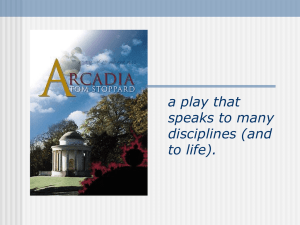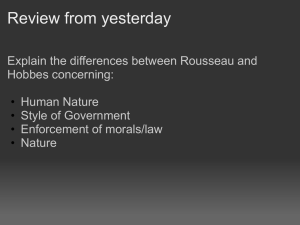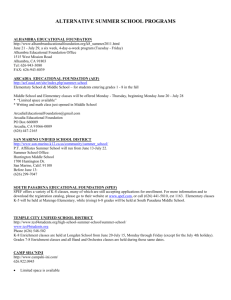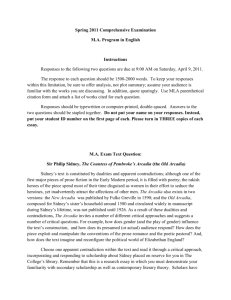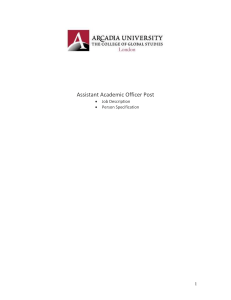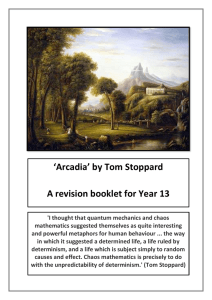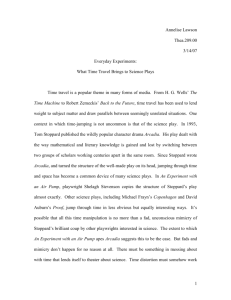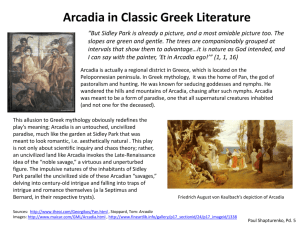I hate it when people ask me what Arcadia is about
advertisement
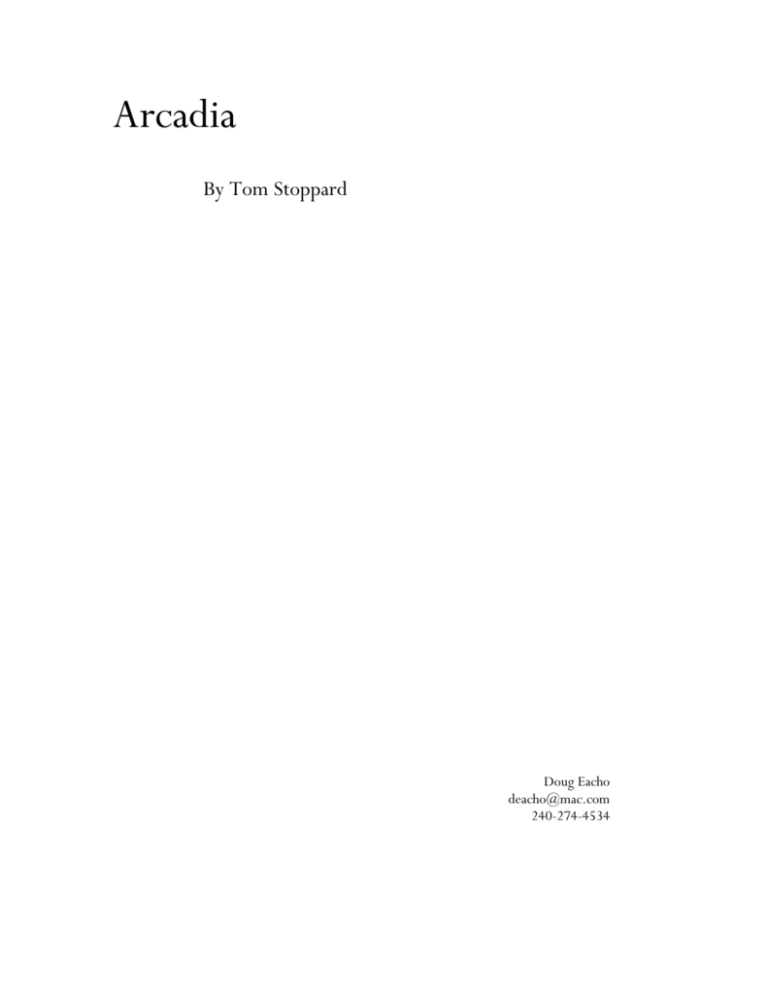
Arcadia By Tom Stoppard Doug Eacho deacho@mac.com 240-274-4534 A simply furnished room in a 19th century English manor. Septimus, 22, is grading at his desk, upstage left. Thomisina, 13, is working at the table that occupies the center of the room, papers spread around her. She looks up, facing the audience. Thomisina: When you stir your rice pudding, Septimus, the spoonful of jam spreads itself round making red trails like the picture of a meteor in my astronomical atlas. (She turns upstage to him, fiercely.) But if you stir backward, the jam will not come together again. Indeed, the pudding does not notice and continues to turn pink just as before. Do you think this is odd? Septimus: No. Thomisina: Well, I do. You cannot stir things apart. Septimus slowly stands, gaining more and more conviction, a rare show of emotion in his dry, professorial demeanor. Septimus: No more you can, time must needs run backward, and since it will not, we must stir our way onward mixing as we go, disorder out of disorder into disorder until pink is complete, unchanging and unchangeable, and we are done with it for ever. (Thomisina is in rapt attention, as Septimus stops himself.) This is known as free will or selfdetermination. (He notices his pet tortoise has strayed to another part of his desk.) Sit! I finished Arcadia on the Amtrak back from visiting a friend in New Haven. I had started it on the way there, already entranced by the charming characters, the heady diversions into academics, and the ridiculously intricate plot. I had long held a desire to direct a fulllength play at Brown, and it had definitely occurred to me that this could be a strong candidate: it was smart, ambitious, young, and definitely doable. But it didn’t truly grab me until I reached the final scene. Arcadia bounces back and forth between two time periods- the early 19th century and modern day- with two casts, both working in the same room. In the final 20 minutes, both casts are onstage at the same time, not acknowledging the other, but speaking over each other, complimenting each other, the two halves composing one coherent linear story. It all builds to (or, more accurately, disintegrates to) a final tableau of two couples waltzing, holding on to each other, confused, scared, and trying their best to waltz even though they’re not very good at it. I nearly cried, but stopped myself, partially because I was on the Amtrak, but mostly because I was immediately irritated at myself. Wasn’t the play about the pitfalls of Romanticism? Wasn’t the love story revealed at the end a bit twisted and unhealthy? What was so moving about two couples waltzing, anyways? And I started to read it again. After all, as I knew then, I had to direct this play. How else could I answer these questions? Arcadia has little concern for plot. There is sex, there is death, there is Lord Byron, there is a duel… but all of those things happen offstage. In fact, if you were to sum up the plot of Arcadia in a sentence, you might end up with “Someone thinks Lord Byron killed another poet over sex, but they’re wrong.” Arcadia is incredibly intelligent, witty, funny, heartfelt, sophisticated, and fun. That said, not much happens. But, of course, that’s the point. Our room onstage, full of scholars and researchers, is the last hold-out against the forces of the outside world, the very forces that would make Arcadia more “exciting”: sex, death, violence. This shelter, though, isn’t very sustainable. All around these characters, things are collapsing. Order progresses into Disorder. Narratives established at the beginning of the play are shown to be inaccurate by its close, the symbolism of some characters is pointed out and ridiculed by others, romances end or start without warning, the Enlightenment gives way to gothic Romanticism, Newtonian physics gives way to quantum messiness, and characters have difficulty coping with the second law of thermodynamics. Some characters abandon their intellectual work for their desire (whether for romance or for fame), others continue their research, only to discover the chaotic nature of the universe. The play ends with the mess of contradictions that so fascinated me on the train. Things don’t build, they collapse, they splinter. It’s deeply unsettling, but in Stoppard’s telling, it’s very beautiful. Arcadia is about how people deal with disorder. It’s about why scholars continue to research topics that yield nothing. It’s about why we fall in love, in face of the disruption and pain that love can cause. It’s about living in the face of death. That’s not to say that the characters deal with pain, disappointment and death well. They struggle, and often fail, falling into depression or anger. The best they can do- perhaps the best we all can do- is comprehend what is going on around them, and when even that isn’t possible, hold on to each other. And, despite everything, try to keep going. STORY In 1817, a tutor reluctantly begins a sex-ed class with his precocious 13-year-old aristocratic pupil. Today, an overly ambitious scholar tries to prove that Byron killed a minor poet in a duel. In 1817, the tutor, not Byron, gets challenged to a duel, but isn’t terribly concerned about it. Today, a mathematician tries to find a pattern in grouse populations. In 1820, our brilliant pupil dies in a fire, and our tutor goes mad over her death. Today, a writer tries to use him as her symbol for the transition between the Enlightenment and Romanticism. Along the way, we are treated (that is, those of us who are nerdy enough to think it’s a treat are- but let’s be honest, that’s a large majority of Brown students) to monologues and debates over romantic poetry, Fermat’s last theorem, drawing, theoretical physics, religion, the steam engine, Cleopatra, and (my personal favorite) gardening history. Someone breaks out into tears over Latin translation. There are seven scenes, alternating between past and present. The room is always the same, and transitions will be lit and fluid. There are no real set changes. If a laptop stays on a desk through the past scenes, nobody notices it. This is one, linear story, not two. At the beginning of the play, all props are doubled- a book in 1817 has its double, looking considerably older, brandished about in the modern scenes. This rule, as the play goes on, starts to get broken more and more frequently. A strange character in the present shows up, double-cast, in the past. Finally, in the seventh scene, the two casts of the play are simultaneously onstage, speaking over each other, next to each other, but never truly acknowledging each other. Arcadia brings itself to the point of collapse, but doesn’t quite get there. That’s left to the audience. Of course, there’s a lot more going on here than people blabbing on about academics and grandiose themes of Order and Chaos. The characters (there are 13, with one doublecasting, so 12 actors) show considerable realism and heart. Septimus, the tutor, quietly loves the charismatic matriarch of the household, but finds refuge in the eager crush of 16-year-old Thomisina, the pupil. Thomisina’s considerably less intellectual modern counterpart, Chloe, carelessly throws herself on the snooty Oxford don, Bernard. A poet tries to retain his dignity, despite the fact that his poetry is terrible, and everyone is screwing his wife. Romance is contrasted with reason, but sometimes they are shown to be quite similar. The play is both a tribute to the intellectual life, and a biting critique of the repressed characters who live it. It’s also, I should add, extremely funny, as the characters sometimes fall back on their wit instead of expressing themselves. The play is rooted in a sharp dialogue that recalls Oscar Wilde, making its departures into profound statements and honest confessions of love all the more remarkable. And there is a live tortoise. DESIGN Order progresses into Disorder. Obviously, this has a lot of design potential, and I think our designs go beyond simple the potentially trite trappings of this theme, finding something definitely cohesive with what Arcadia is exploring, but also very beautiful. SET Jenny Filipetti’s set begins with the simple room described in the script: simple walls and furnishings that fit comfortably in both time periods. But at the end of Act 1, as the characters exit the space and we hear a gunshot slightly out of context: a small intrusion of violence into our composed world. And a panel of wallpaper falls off of its frame, revealing behind it a network of string webbed over the back of the frame. As the second act progresses, particularly in the strange, ethereal final scene, more and more panels fall. The borders of the world the characters have created are crumbling in face of the external forces of chaos. What is revealed is all they have left: connections, relationships, networks that might be unreliable and certainly can’t be analyzed or understood like the science or poetry that so preoccupies them- but that is what is left over after shock, deconstruction, and death. At the close of the play, all of the wall panels have fallen, leaving the characters exposed and vulnerable in the face of a beautiful disorder. The three walls of the set will be made up of several panels, each made of a wooden frame with canvas stretched across the downstage side. The canvas sheets will be held in the back by string, which can easily be snapped off (either all at once, or in sections, so a corner drapes down, then another corner…). And behind all of the wooden panels runs a web of strings, that- when all of the canvas sheets have been taken down and all of the frames are bare- will be a cohesive, beautiful (though chaotic) design. MUSIC Music is extremely important to me, and to the play. Arcadia, as Stoppard writes it, features a piano (offstage) that is played by several characters throughout the play, and ends up being very crucial in the final scene (Septimus teaching Thomisina how to waltz). I have worked with Katharine Joo, one of Brown’s best pianists, on expanding the role of the piano throughout the play and selecting appropriate pieces. Further, instead of using recordings throughout the play, Katharine will be playing, live, behind one of the side walls. This will allow her to adjust the tempo and pace of her playing to match up with the onstage action (though, obviously, this will be extensively worked through in rehearsals), and it will provide the audience with the irreplaceable joy of engaging with live music. The piano, as with the entire play, begins governed by simple rules: it is always diegetic, and it always plays music appropriate to the period. Of course, by the end of the play, these rules have become a bit unclear, and then progressed to being blatantly violated. The music, as with the set, will chart the progression from ordered, simple music, to lush, strange, modal music that closes the play. Sometimes the music adds a sense of intrigue, fragility, and etherealness to the action, at other times the music’s intense Romanticism will be in opposition to the tenuous awkwardness that passes for romance onstage. I would love to talk more about the music design in the interview, especially in the final scene, which is almost entirely set to piano music, which we have wholly mapped out. I will also come with my laptop and speakers, so I can play some of this beautiful music for you. COSTUMES Period costumes! Period costumes! Yay! (Specifically, the costumes in the Past scenes are in the Regency style- think Jane Austen movies). Regency clothes tended to be a bit flamboyant and heavy on accessories, aspects that we’re cutting down on. Historical accuracy isn’t really our aim with costumes. Instead, Emily and I will design costumes that certainly are in the Regency style, but that have a simplicity and cohesiveness (with a color palette that crosses both time periods) that emphasizes the conceptual, abstracted nature of this production. This will also, conveniently, be cheaper. We also intend to steal borrow from the mainstage costume shop and Trinity Rep to try to keep costs to a minimum. (We probably won’t budget much money towards the modern costumes). PROPS A large part of the collapse into chaos that drives Arcadia is actually blatantly written into the script in the form of props. Quite frankly, there’s a lot of shit onstage by the end of the play. Characters bring on magazines, research, mounds of paper, laptop computers, drawings, a complicated apparatus for making tea, lamps and candles, and- as I mentioned- a live tortoise. Pretty much none of this is ever taken offstage. Information accumulates, mixes, and ultimately is a destructive force: though the characters are often trying to find order in their research, they usually accomplish the opposite- their work leads them to discover how strange and chaotic the world actually is. Emily Toner will be heading up props design, creating most of the drawings and diagrams herself, and helping me spearhead the search for a Brown student who has a pet tortoise. LIGHTS Hey, you know that lighting designer you know? The one who’s not doing anything right now? Who would totally love to take on Arcadia because that’s just how much they love The Theatre? They’re pretty talented, I think. Their designs will be pretty impressive. In all seriousness, though we do not have a lighting designer (and not from lack of trying), I have put a lot of thought into lighting design. Specifically, I think Arcadia’s lighting design will be a pretty big departure from what I’ve seen at PW over the past year. There will be no sudden changes, no blackouts, no funky masks or effects. That’s not to say that the lighting will be entirely naturalistic, though. Certainly, lighting will be used to signify time of day and weather (there are points when it really has to). And, like all of the design, it will be much more straightforward and natural at the play’s start than at the end. What I’m really looking for is a design with flow, slow changes, and subtlety. This play is not a jagged back and forth between two plotlines. It is one linear progression, and lighting will have a huge role in conveying that. Colors will change over long chunks of scenes, they will dim and brighten softly but importantly. Audience members will feel a scene change coming pages before it actually happens because of the forward movement of the lights. Of course, this will be a significant challenge for any lighting designer, but I think that there is a lot of talent at Brown that’s totally up to the task. We just have to, you know, kidnap them and lock them in downspace for a week. PROCESS I am extremely excited to work with Brown’s immensely talented student actors to get this production out of my head and make it real. While I have my own specific plans for the rehearsal process- which I’ll get to in a second- I fully intend to work with my actors to refine this process, asking for their ideas for exercises, their feedback on what we’re doing, and their work on their (and others’) characters. My goal in rehearsals is to guide the actors into finding the happy balance between naturalism and symbolism that Stoppard has written into the script. Staging will be largely still, both emphasizing the abstract nature of the play, and allowing that much more shock to accompany the character’s occasional breaking of rules, displays of emotion, and child-like energy. Mostly taking from Viewpoints work, we’ll start with two intensive, cast-wide rehearsals: one a read-through and thorough table work on every major theme and character, the next a physical introduction to the “soft focus” emphasized by Viewpoints, and quick exercises with the play in mind, forcing the actors to start making impulsive, intuitive decisions regarding their characters (I have specific exercises in mind, you can ask me about them in the interview.) Then we will immediately begin scene work, still with Viewpoints in play: working with exaggerated distance, tempo, emotions, and physicalities and then re-staging with those exercises in mind, informing our work. Hopefully we will have very tentative blocking in place within two weeks (casts, of course, will alternate nights, though a LOT of time will be spent on the joint-cast scene 7), and have a third week to more thoroughly delve into our characters before tech week. I’ll also have the actors do research on their respective character’s academic focuses, to help get in the mood of the world of Arcadia (it’s the actual researching and time with books that’s important, not whatever they’ll be reporting back on). Throughout, I will either serve to remind the actors of the big themes they’re grappling with, or to bring them down to earth. I’ll also work with my stage manager, Mark Stokely (who I worked with and was extremely impressed with in TA3), to keep an eye on the many technical aspects of the show throughout rehearsals- accent work, keeping the dialogue fast and sharp, and working with live music. Mounting this large production in a month will be difficult, but I feel fully prepared to do so, and can’t wait to start. DO IT. Arcadia is, admittedly, a relatively well-known play by a very well-known playwright. (Unsurprisingly, teachers enjoy assigning a play about sexy teachers and eager students.) But we are presenting Arcadia in a way that probably departs from most people’s expectations about the play, keeping it dark, moody, and very designed. Also, reading a play is a poor substitute for seeing it performed, and while Arcadia is often read, it has never been revived in New York, and is rarely done in high schools, so few Brown students will have ever seen the play. That many Brown students know of Arcadia will only generate excitement for the production, and, PW being PW, the audience (and make no mistake, there will be a HUGE audience for this play) will probably come in expecting to see an Arcadia a bit divergent than what they read in high school English, and still expect to be amused, entertained, moved, and enthralled. I fully intend to deliver. It has been over three years since PW put on The Invention of Love (fall first slot ’05), and the time is certainly ripe to show Brown another full-length Stoppard play, and to allow Brown actors to engage with such a bright, witty text. Specifically, while the themes of Arcadia are rather obviously collegiate and academic, I think they are particularly relevant to Brown, today. Our world is decidedly anti-intellectual. I don’t just mean that in a political “I-can’t-believe-people-don’t-believe-in-evolution” sense; even within Brown, there is a resistance to showing intense passion over one’s studies. I have difficulty imagining a Brown student earnestly reacting to algorithmic graphs with Hannah’s “Oh! But… how beautiful!” Arcadia is, in many ways, a paean to a lost world of sincere intellectuals, an age where being intelligent meant that one was educated in a huge host of subjects, and to people who would rather curl up in a sweater and study 19th century landscaping than socialize. It’s not preachy, and this intellectual life is definitely subjected to criticism. But, as a students in a modern university, it’s extremely refreshing to see such love of learning and innocence, and I have few hopes for Arcadia as great as the hope that the audience will walk away from the show with a more earnest but more rich view of academics, of their relationships, and of the beauty inherent in the order and chaos both so prevalent in our world. Finally, Arcadia will demonstrate PW’s ability not just to create challenging, subversive art, but to craft a more straightforward play with polish, excellence, and grace. It will show that PW can put on a more lengthy play, and that Brown students will sit through it. It will be funny, grieving, charming, sinister, sincere, witty, light and dark, romantic and intellectual… a mess of contradictions that is ultimately incredibly grandiose and ambitious and still irrevocably human. It’s life, brought to you for two hours by 12 actors and a tortoise. And you, PW. Here’s one last moment I’ll leave you with. The italics are my own notes (as with the top). The end of scene 6. The play is beginning to approach its ending. It is the middle of the night, the set is bathed in blue. Several walls have already come down, the intricacies of string webbing behind revealed. The piano begins, Romantic but with very strange, modern opening harmonies- a spacious, beautiful piece that has shown itself in snatches throughout the earlier scenes and transitions. Lady Croom confronts Septimus about a love letter to her she discovered, and his recent tryst with the house’s resident ho-bag, Mrs Chater. He is seated, deferring to Croom’s striking self-confidence and beauty as she stands, center, berating him. Lady Croom: Your letter to me goes very ill with your conduct to Mrs Chater, Mr Hodge. I have had experience of being betrayed before the ink is dry, but to be betrayed before the pen is even dipped, and with the village noticeboard, what am I to think of such a performance? Septimus: My lady, I was alone with my thoughts in the gazebo, (a panel begins to fall) when Mrs Chater ran me to the ground, and I being in such a passion, in an agony of unrelieved desireCroom: Oh! (More of the panel peels off, the music builds) Septimus: - I thought in my madness that the Chater with her skirts over her head (snap! More of the panel peels off, picking up pace as Septimus goes with it, more and more energized by his uncharacteristic sincerity) would give me the momentary illusion (snap!) of the happiness to which I dared not put a face. (The entire panel collapses.) (Pause. Septimus is still seated, but barely. Croom takes a second to compose herself, and while a lesser woman might show her embarrassment, Croom meets Septimus’s slightly fearful gaze.) Croom: I do not know when I have received a more unusual complement, Mr Hodge. I hope I am more than a match for Mrs Chater with her head in a bucket. Does she wear drawers? Septimus: She does. (slowly, the lights begin to shift, the sun rising for the next scene) Croom: Yes, I have heard that drawers are being worn now. It is unnatural for women to got up like jockeys. I cannot approve. (Croom crosses to the stage left door, and pauses.) I know nothing of Pericles or the Athenian philosophers. I can spare them an hour, in my sitting room when I have bathed. Seven o’clock. Bring a book. Septimus stays seated, unsure what sort of invitation he has just received, and finally exits when he has no choice, the play is moving on without him. The music and lights continue their development into the next, and final scene. The present-day cast marches on with more stuff, more papers, more chaos, as everything mixes together. Always moving forward. Never looking back. I am bursting with ideas, excitement, and energy. Please let me create this before that energy goes stale, and please let Brown experience this masterpiece the only way it really can be understood: performed, in a theater, live, intimate, immediate. Thank you. STAFF Production Manager- Alex Lubensky Stage Manager- Mark Stokely Assistant Stage Manager- freshman!! Set Designer- Jenny Filipetti Music (selection and performance) - Katharine Joo Costume Designer- Emily Fishman (mentor: Lucy Sedgwick) Props Designer- Emily Toner Lighting Designer- my new best friend BUDGET Set: 200 Costumes: 200 Props: 120 Lights, Sound: 30 Printing/stuff: 100
